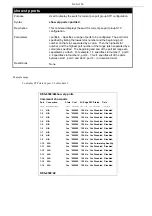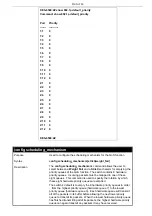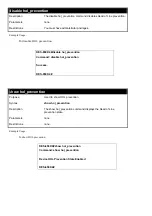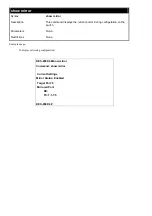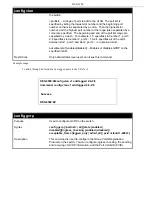
config scheduling
Purpose
Used to configure traffic scheduling for each of the switch’s QoS
queues.
Syntax
config scheduling <class_id 0-6> {max_packet <value 0-15>|
Description
The switch contains eight hardware priority queues per device. The
switch’s default settings draw down the seven hardware queues in
order, from the highest priority (Class 6) to the lowest priority (Class 0).
Starting with the highest priority queue (Class 6), the highest priority
queue will transmit all of the packets and empty its buffer before
allowing the next lower priority queue to transmit its packets. The next
highest priority queue will empty before proceeding to the next queue
and so on. Lower priority queues are allowed to transmit only if the
higher priority queue(s) in the buffer are completely emptied. Packets in
the higher priority queues are always emptied before any in the lower
priority queues regardless of latency or volume of the lower priority
queues.
The default settings for QoS scheduling employ this strict priority
scheme to empty priority queues.
The
config scheduling
command can be used to specify the round
robin rotation by which these four hardware priority queues are
reduced. To use a round-robin scheme, the max_packets parameters
and/or the max_latency parameters must be changed from the default
value of 0.
The
max_packets
parameter allows you to specify the maximum
number of packets a given priority queue can transmit before allowing
the next lowest priority queue to begin transmitting its packets. A value
between 0 and 15 packets can be specified. For example, if a value of
5 is specified, then the highest priority queue (queue 3) will be allowed
to transmit 5 packets. Then the next lower priority queue (queue 2) will
be allowed to transmit 5 packets, and so on, until all of the queues have
transmitted 5 packets. The process will then repeat.
Parameters
<class_id>
−
Specifies which of the four priority queues the
config
scheduling
command will be applied to. The seven priority queues are
identified by number
−
from 0 to 6
−
with queue 6 being the highest
priority.
max_packet <value 0-15>
−
Specifies the maximum number of packets
the above specified priority queue will be allowed to transmit before
allowing the next lowest priority queue to transmit its packets. A value
between 0 and 15 packets can be specified. The default value is 0.
Restrictions
Only administrator-level users can issue this command.
NOTICE:
The default QoS scheduling arrangement
is a strict priority schedule. To customize
scheduling to set up weighted or round-robin queue
clearing the max_latency and max_packets values
need to be changed.
Example usage:
To configure traffic scheduling:
Summary of Contents for TM DES-6500
Page 6: ...Register online your D Link product at http support dlink com register vi...
Page 33: ...DES 6500 Example usage To terminate the current user s console session DES 6500 4 logout...
Page 62: ...DES 6500 4 disable rmon Command disable rmon Success DES 6500 4...
Page 128: ...DES 6500 4 disable ipif s2 Command disable ipif s2 Success DES 6500 4...
Page 262: ...DES 6500 4 config command_history 20 Command config command_history 20 Success DES 6500 4...
Page 266: ......
Page 267: ...1...


